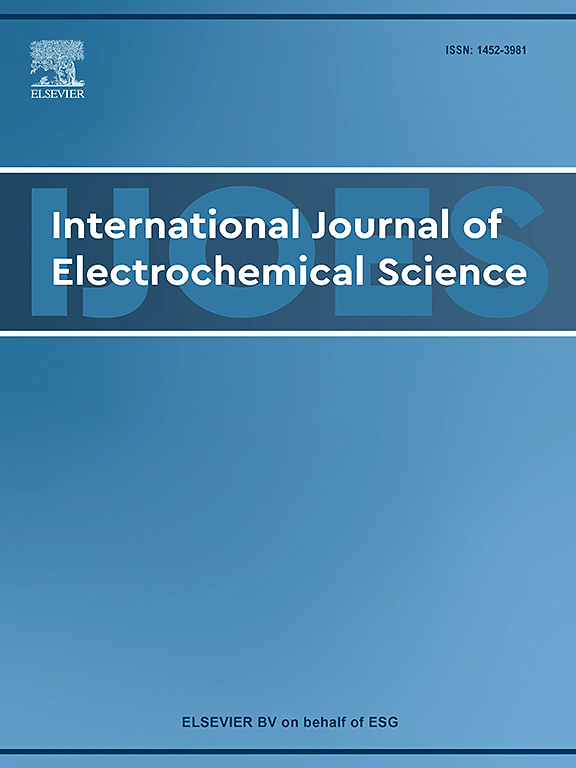Simultaneous Electrochemical Impedance Spectroscopy and Magnetic Resonance Imaging analysis of lithium-ion batteries
IF 2.4
4区 化学
Q4 ELECTROCHEMISTRY
International Journal of Electrochemical Science
Pub Date : 2025-07-16
DOI:10.1016/j.ijoes.2025.101129
引用次数: 0
Abstract
Electrochemical Impedance Spectroscopy and Magnetic Resonance Imaging (MRI) were measured simultaneously on Lithium-Ion batteries. The motivation for developing this measurement method was the following: While Electrochemical Impedance Spectroscopy provides integral information on processes in the battery, MRI adds spatially resolved information on structures and their changes in the battery on a microscopic length scale. This offers combined and more comprehensive information on microscopic and integral levels. A significant benefit of simultaneous measurement is that the battery is in the same state as well as that it allows continuous measurement of a specific battery thus avoiding replacements and rest times when exchanging parts of the experiments. Comparative measurements of Electrochemical Impedance Spectroscopy, performed in parallel to MRI and outside of the MRI setup, however, require optimal decoupling of the electromagnetic fields involved in both techniques. The current version shows only minor differences in the impedances measured below 20 Hz. On the other hand, images were acquired with and without parallel Electrochemical Impedance Spectroscopy, the images show the same structural features. Differences are on the noise level of the MRI measurement. The combination of results of both techniques allows for a thorough detection and identification of the batteries behavior. For example, in the case of two fresh batteries, increased resistance could be assigned to inhibited ionic transport paths due to a misplaced separator. In aged and defective batteries, the combination of both techniques revealed the loss of electrolyte to be the main source of degradation.
锂离子电池的同步电化学阻抗谱和磁共振成像分析
同时测量了锂离子电池的电化学阻抗谱和磁共振成像(MRI)。开发这种测量方法的动机如下:电化学阻抗谱提供了电池过程的完整信息,而MRI在微观长度尺度上增加了电池结构及其变化的空间分辨信息。这提供了微观和整体层面的综合和更全面的信息。同时测量的一个重要好处是电池处于相同的状态,并且它允许对特定电池进行连续测量,从而避免在交换部分实验时更换和休息时间。然而,电化学阻抗谱的比较测量,与MRI并行进行,并且在MRI设置之外,需要两种技术中涉及的电磁场的最佳解耦。目前的版本显示,在20 Hz以下测量的阻抗只有微小的差异。另一方面,采用并行电化学阻抗谱法和不采用并行电化学阻抗谱法获得的图像显示出相同的结构特征。不同之处在于MRI测量的噪声水平。结合两种技术的结果,可以对电池的行为进行彻底的检测和识别。例如,在两个新电池的情况下,由于错位的分离器,增加的电阻可能分配给抑制离子传输路径。在老化和有缺陷的电池中,两种技术的结合表明,电解质的损失是电池退化的主要原因。
本文章由计算机程序翻译,如有差异,请以英文原文为准。
求助全文
约1分钟内获得全文
求助全文
来源期刊
CiteScore
3.00
自引率
20.00%
发文量
714
审稿时长
2.6 months
期刊介绍:
International Journal of Electrochemical Science is a peer-reviewed, open access journal that publishes original research articles, short communications as well as review articles in all areas of electrochemistry: Scope - Theoretical and Computational Electrochemistry - Processes on Electrodes - Electroanalytical Chemistry and Sensor Science - Corrosion - Electrochemical Energy Conversion and Storage - Electrochemical Engineering - Coatings - Electrochemical Synthesis - Bioelectrochemistry - Molecular Electrochemistry

 求助内容:
求助内容: 应助结果提醒方式:
应助结果提醒方式:


